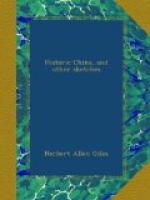The note following this last sentence is still more extraordinary:—
“An inquest was held on the body of a man who had been murdered on the high road, and at first it was thought that the murder had been committed by robbers, but on examination the corpse was found to be fully clothed and bearing the marks of some ten or more wounds from a sickle. The coroner pointed out that robbers kill their victims for the sake of booty, which evidently was not the case in the present instance, and declared revenge to be at the bottom of it all. He then sent for the wife of the murdered man, and asked her if her husband had lately quarrelled with anybody. She replied No, but stated that there had been some high words between her husband and another man to whom he had refused to lend money. The coroner at once despatched his runners to the place where this man lived, to bid the people of that village produce all their sickles without delay, at the same time informing them that the concealment of a sickle would be tantamount to a confession of guilt. The sickles were accordingly produced, in number about eighty, and spread out upon the ground. The season being summer there were a great quantity of flies, all of which were attracted by one particular sickle. The coroner asked to whom this sickle belonged, and lo! it belonged to him with whom the murdered man had quarrelled about a loan. On being arrested, he denied his guilt; but the coroner pointed to the flies settling upon the sickle, attracted by the smell of blood, and the murderer bent his head in silent acknowledgment of his crime.”
Inquests are often held in China many years after the death of the victim. Give a Chinese coroner merely the dry and imperfect skeleton of a man known to have been murdered, and he will generally succeed in fixing the guilt on some one. To supplement thus by full and open confession of the accused is a matter of secondary difficulty in a country where torture may at any moment be brought to bear with terrible efficacy in the cause of justice and truth. Its application, however, is extremely rare.
“Man has three hundred and sixty-five bones, corresponding to the number of days it takes the heavens to revolve. The skull of a man, from the nape of the neck to the top of the head, consists of eight pieces—that of a Ts’ai-chow man, of nine; women’s skulls are of six pieces. Men have twelve ribs on either side; women have fourteen.”
The above being sufficient to show where the Chinese are with regard to the structure of the human frame, we will now proceed to the directions for examining bones, it may be months or even years after death.




